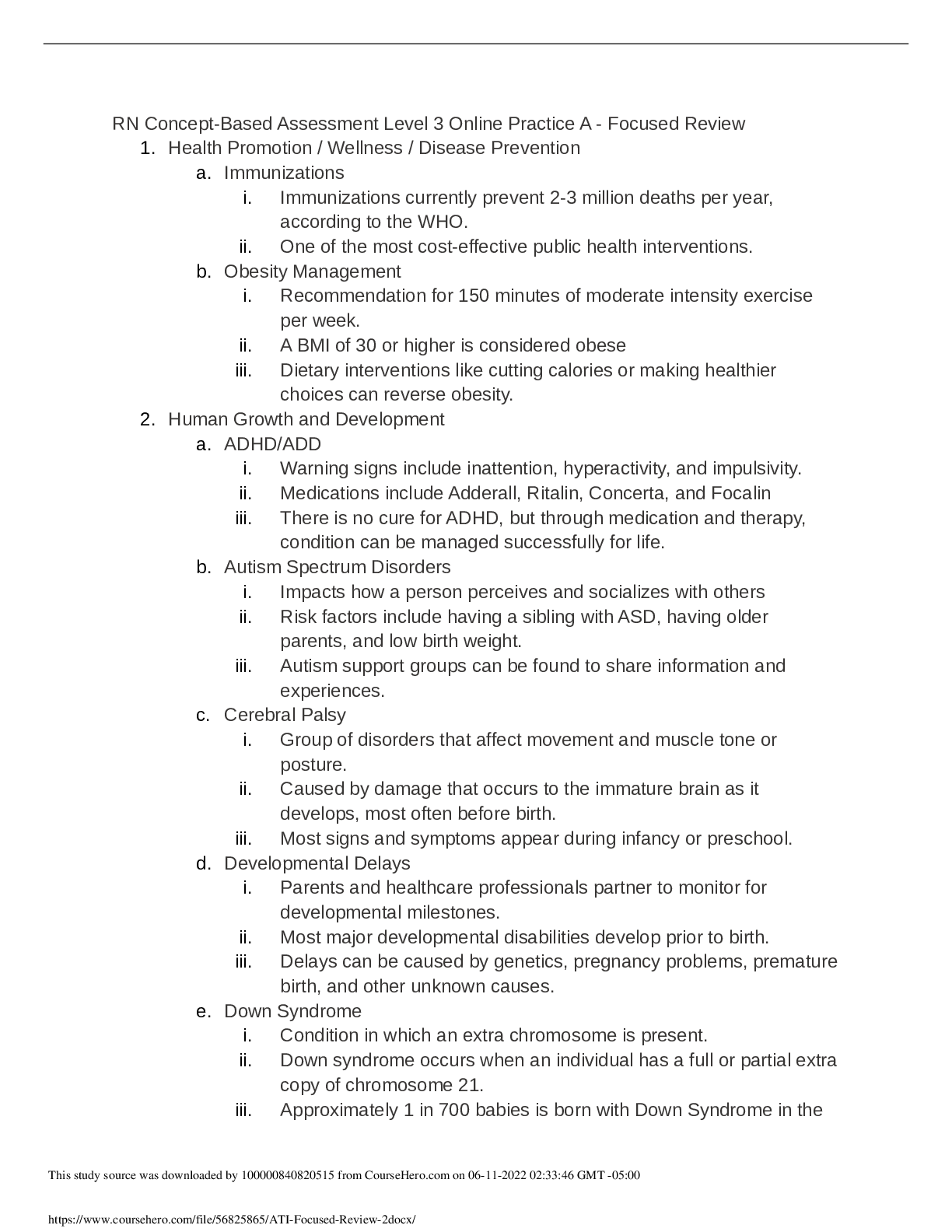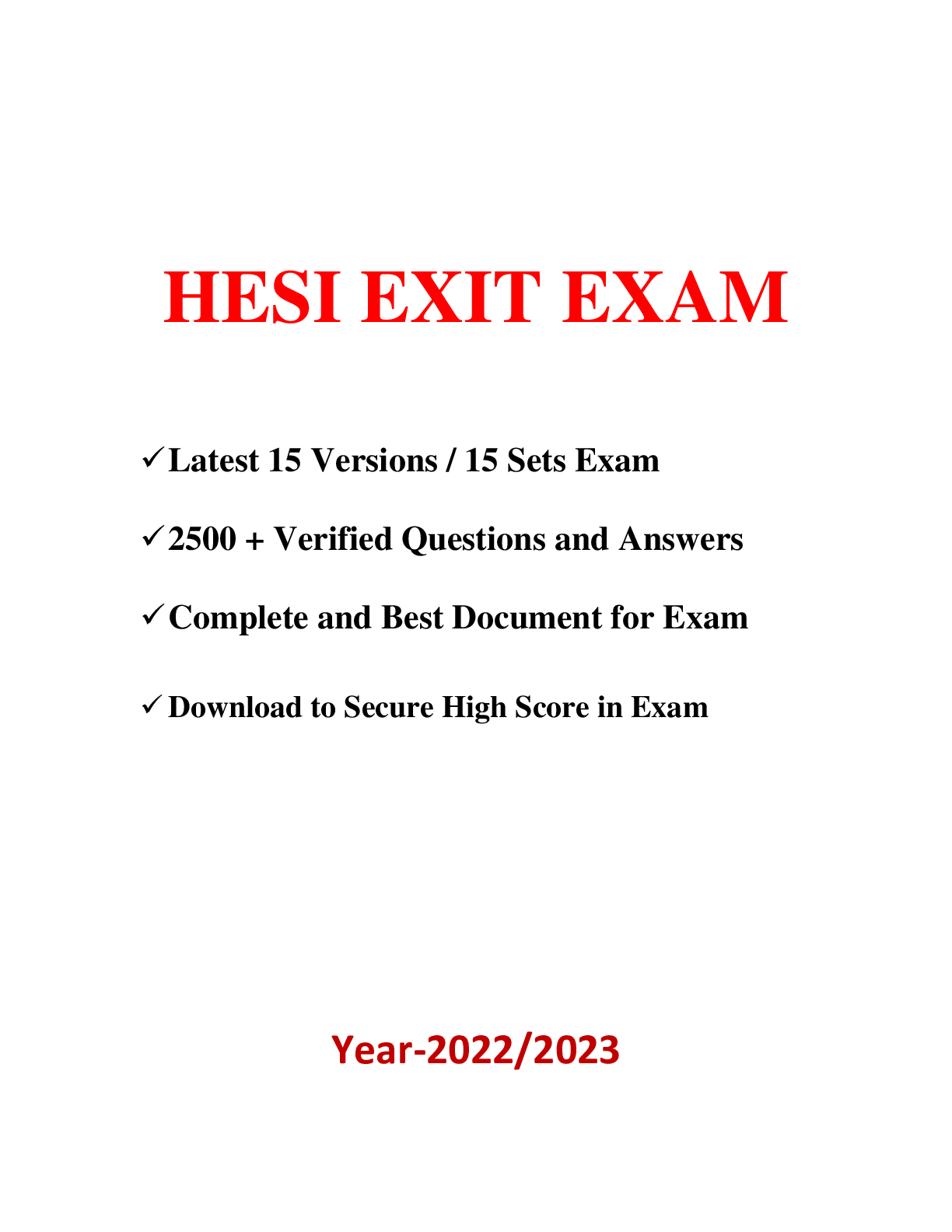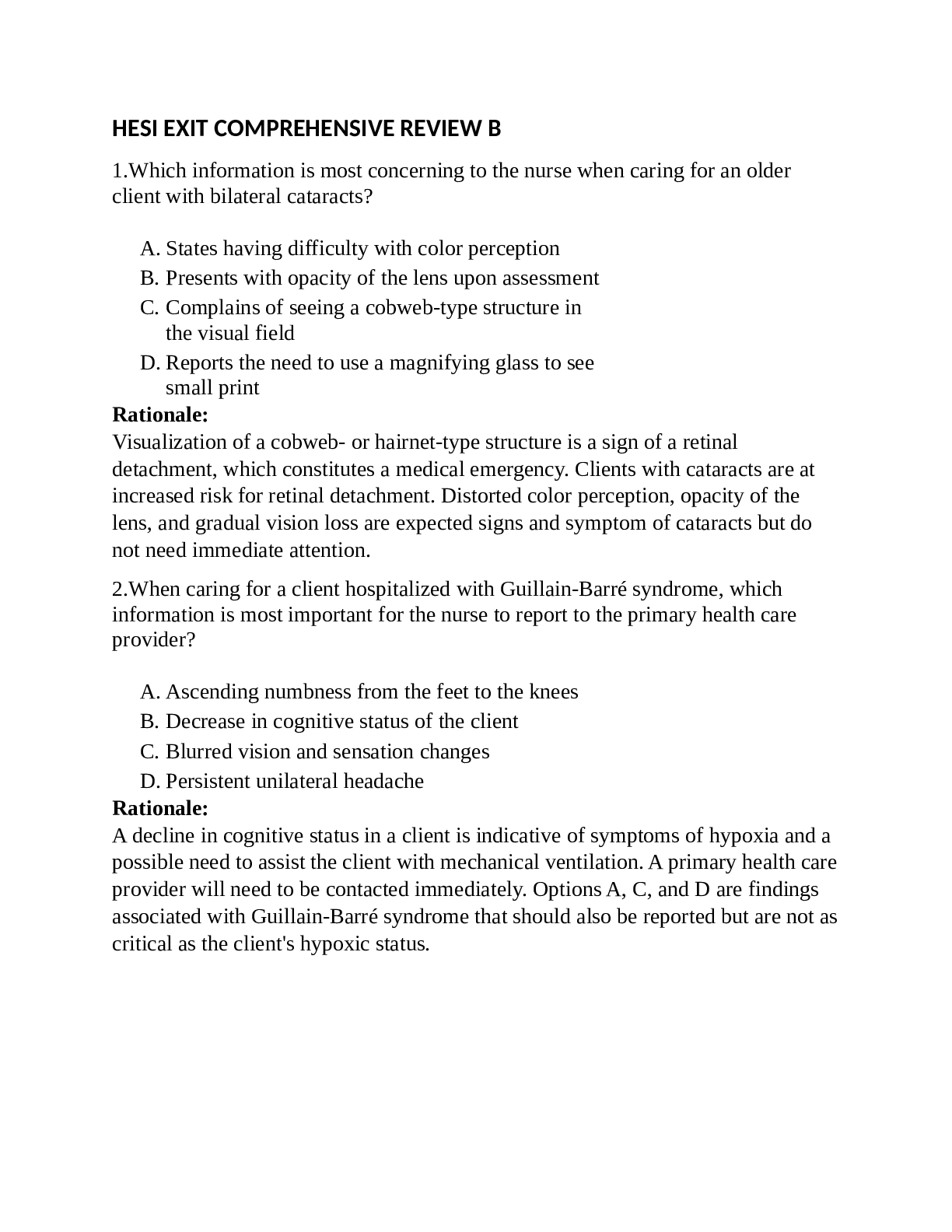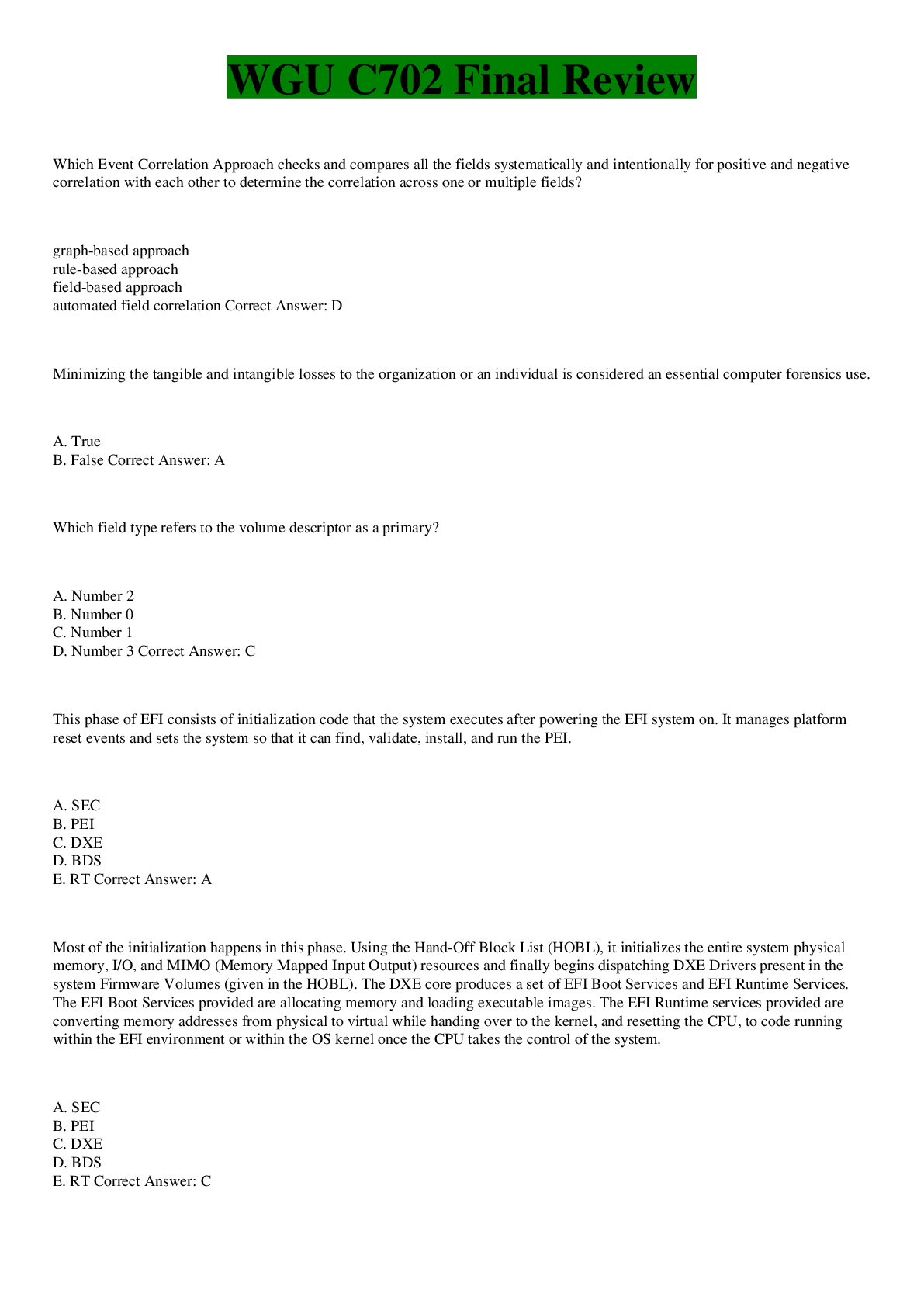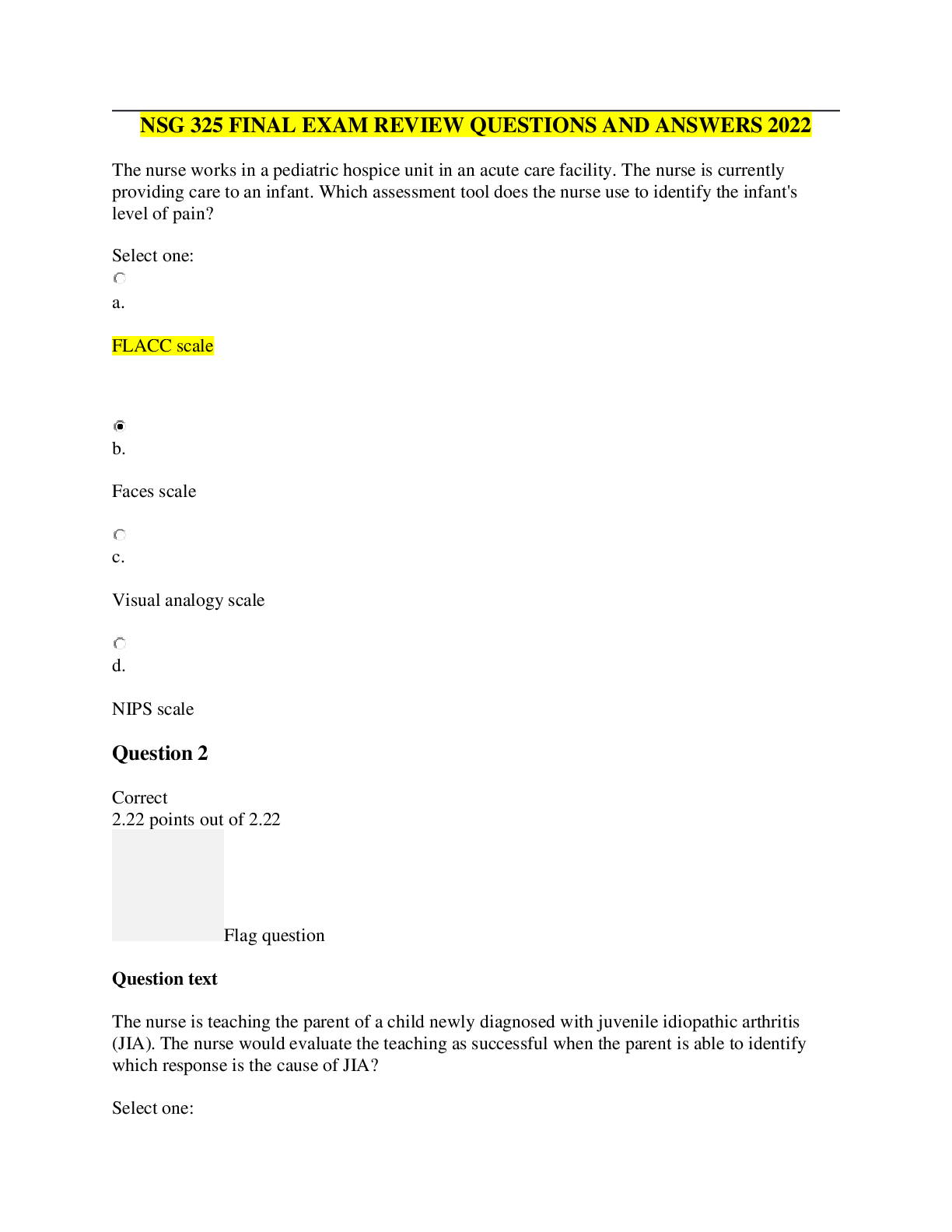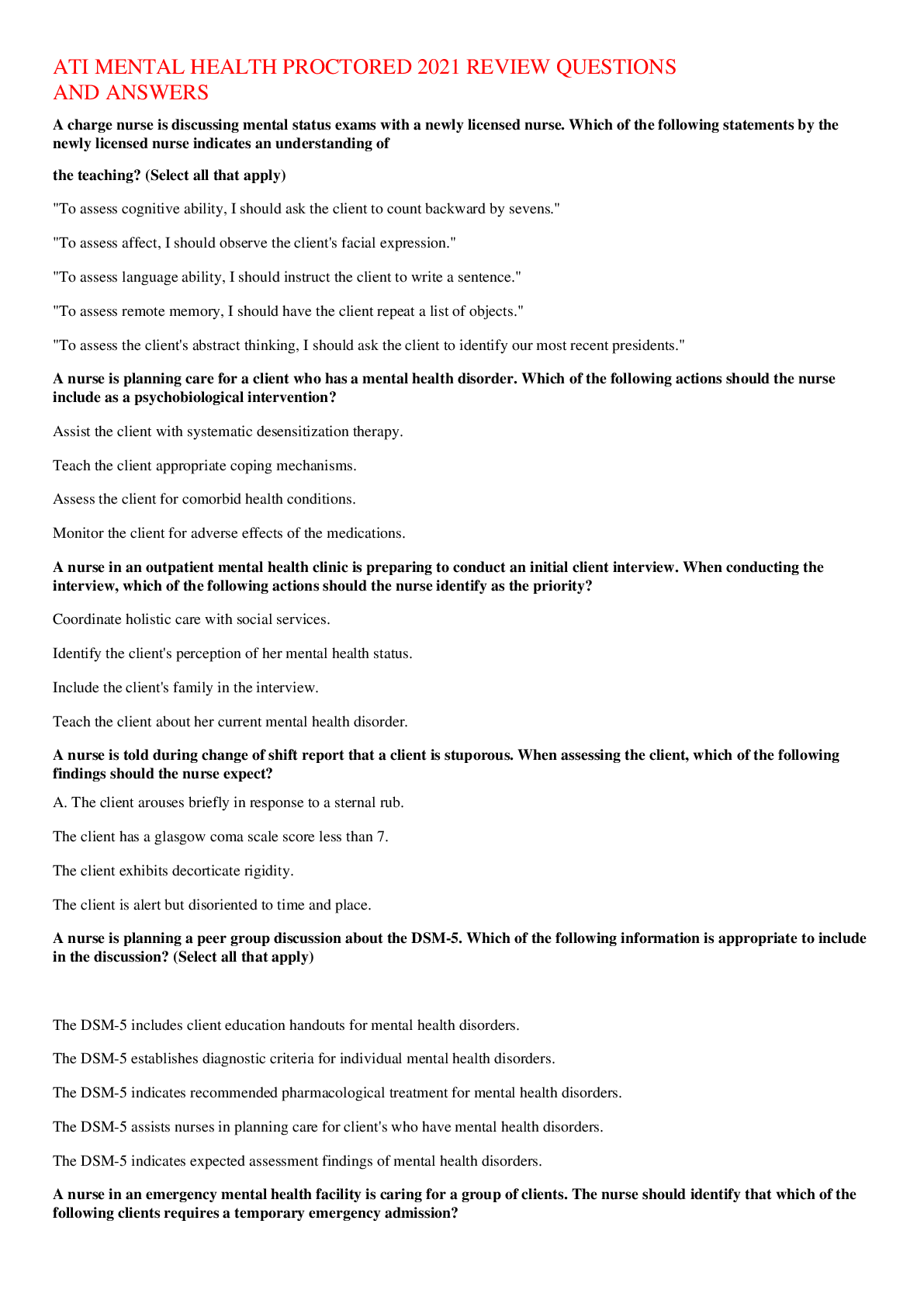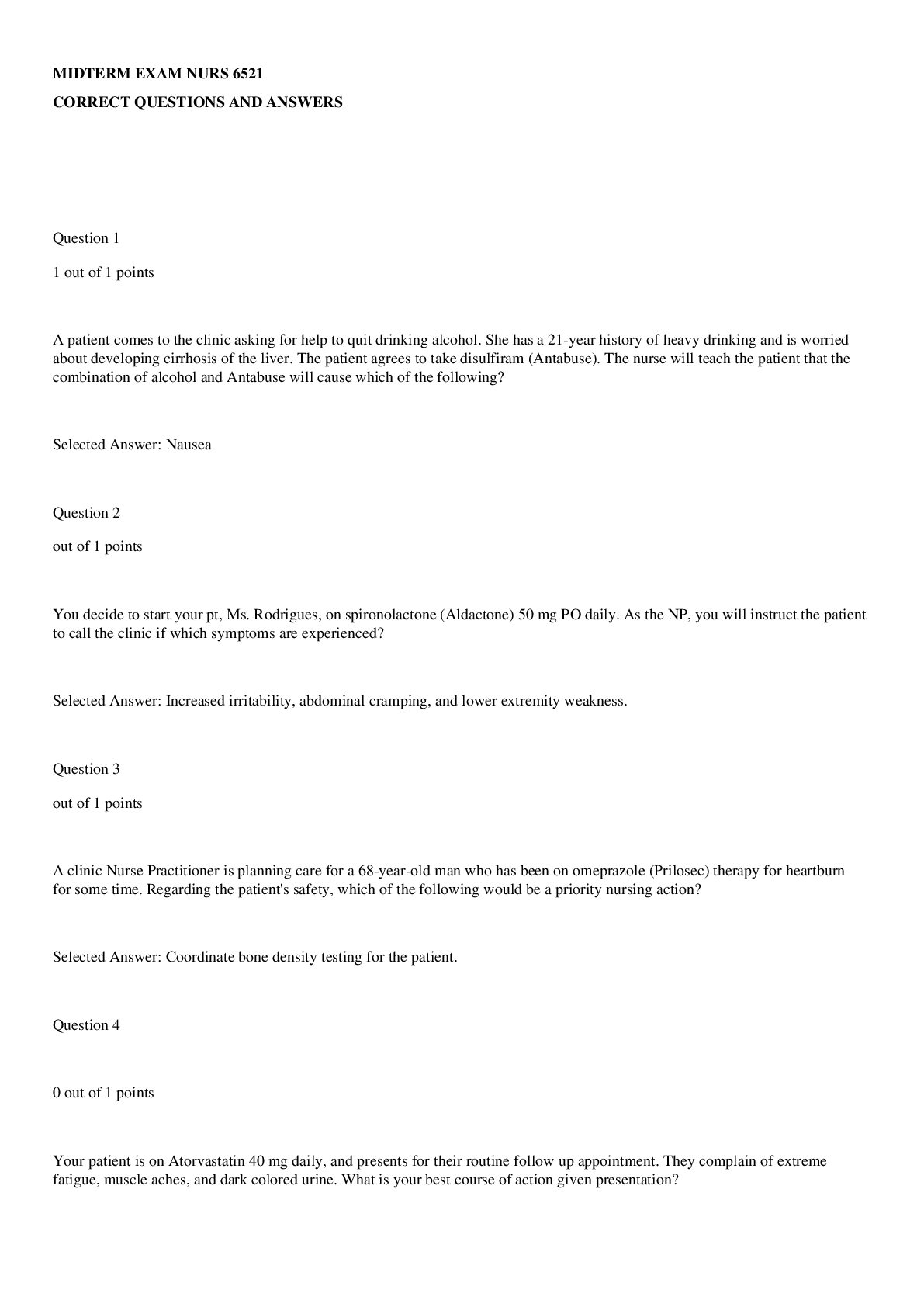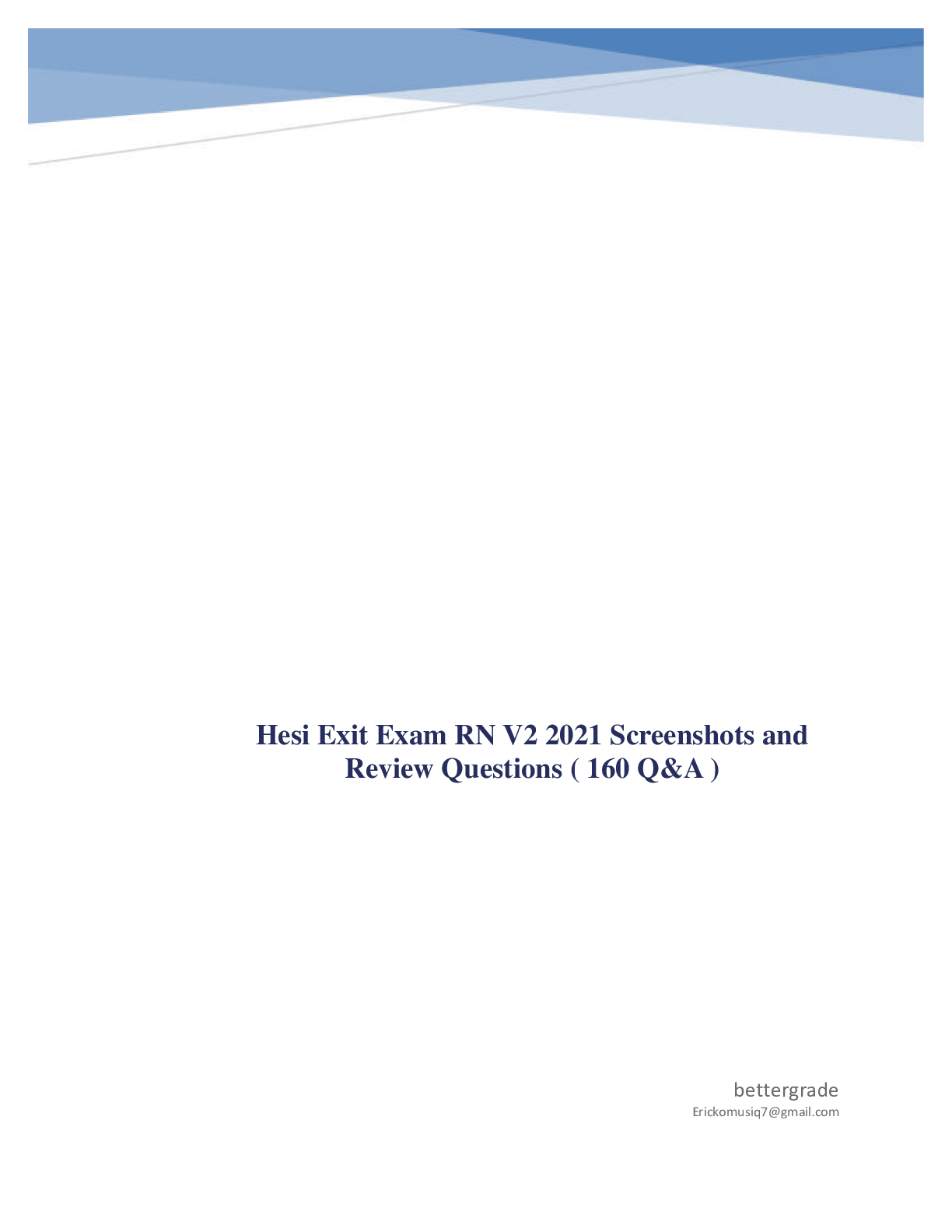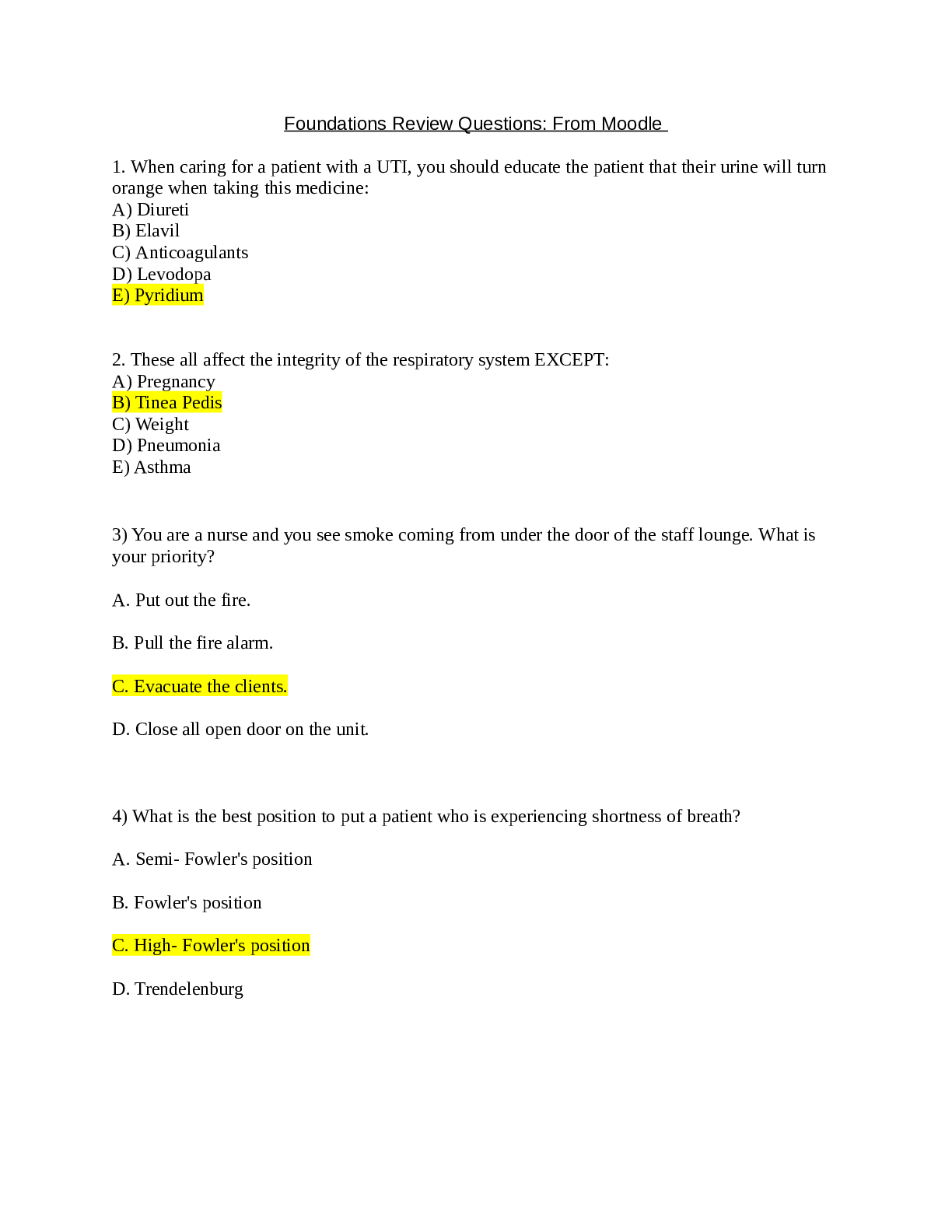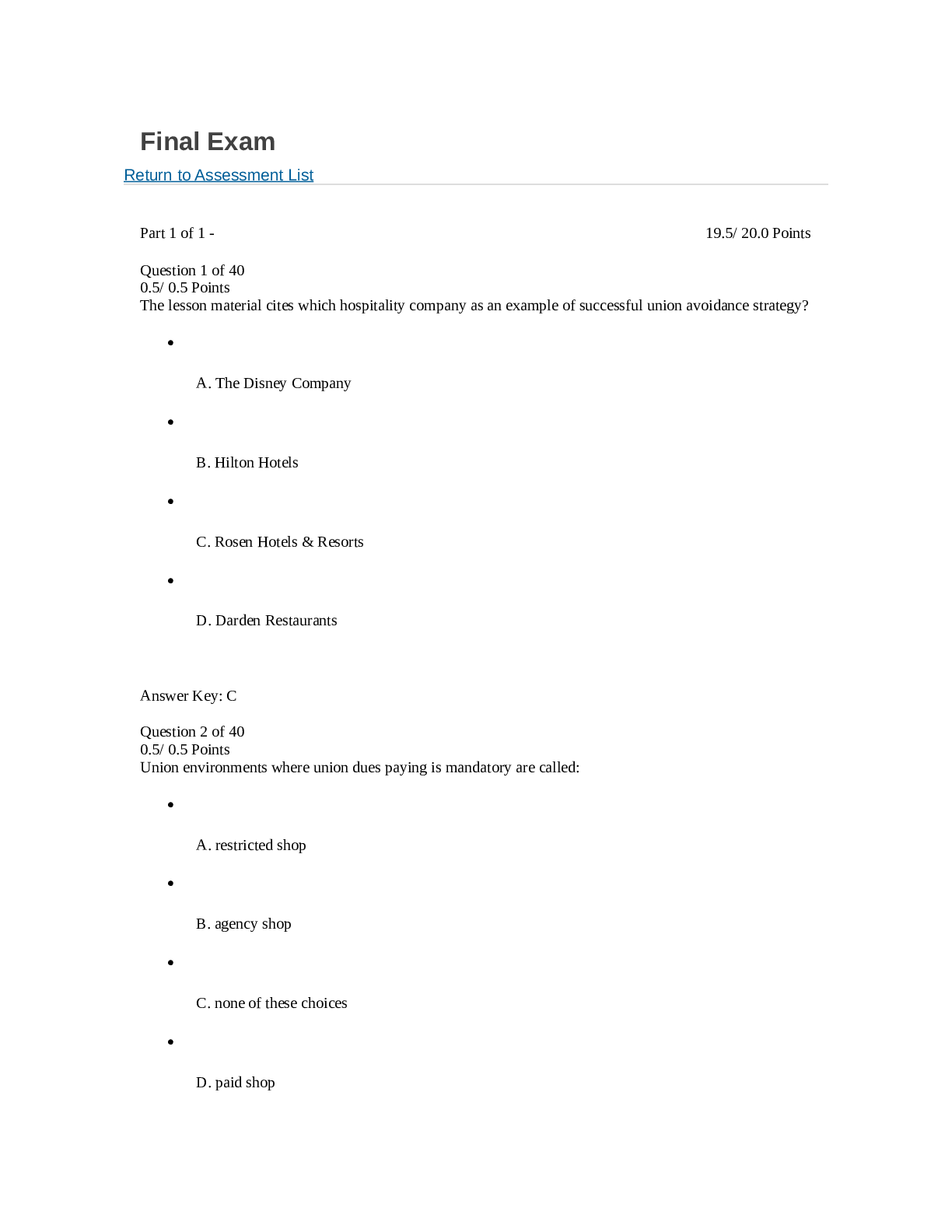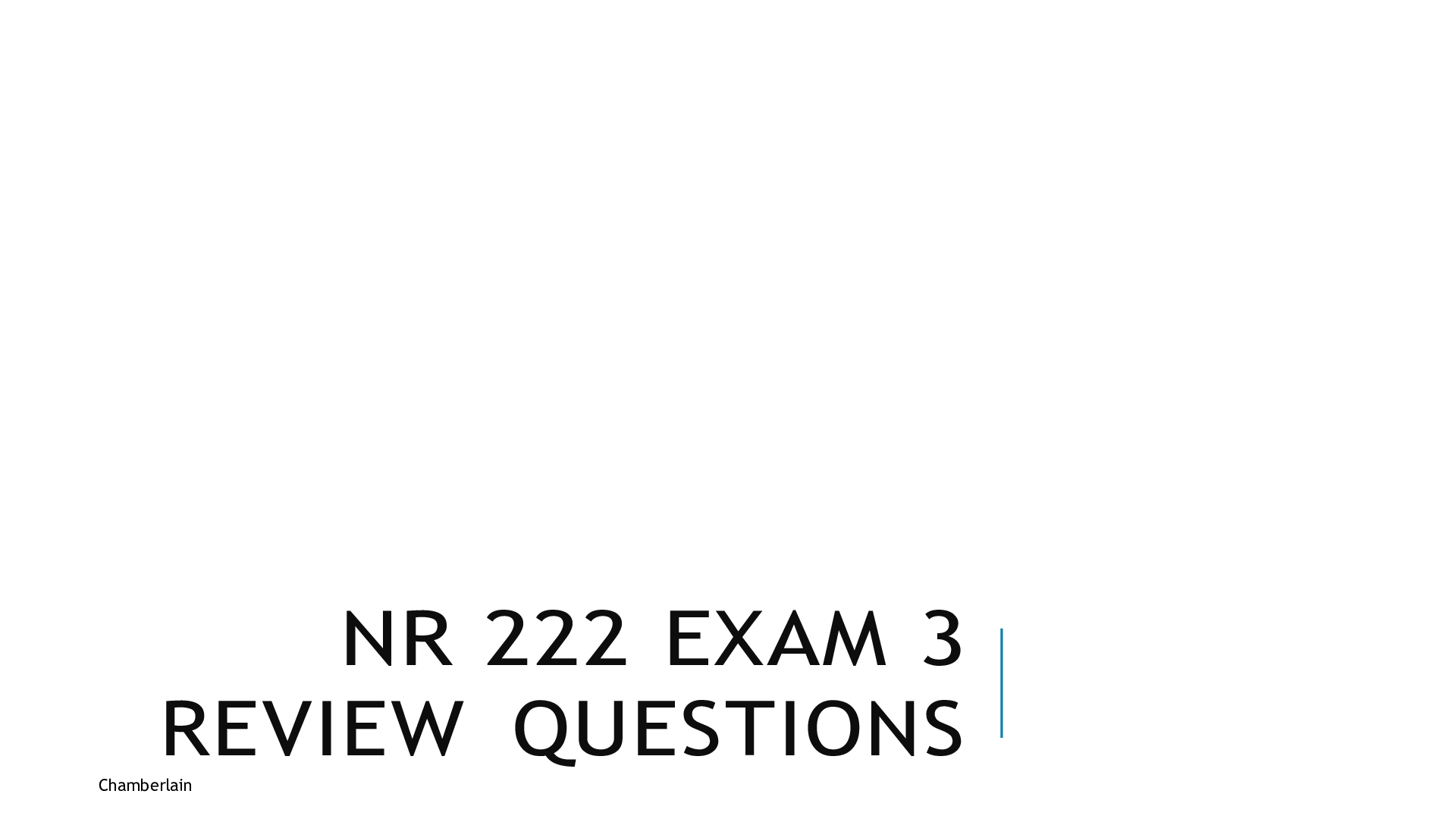*NURSING > EXAM REVIEW > NR 304 Week 4 Musculoskeleton Review Questions and Answers with explanations | Distinction Guarantee (All)
NR 304 Week 4 Musculoskeleton Review Questions and Answers with explanations | Distinction Guaranteed
Document Content and Description Below
NR 304 Week 4 Musculoskeleton Review Questions and Answers Review Questions - NCLEX - Chapter 22 Assessment Performance • Overview • Incorrect • Correct Question 1 of 10 Heberden and Bou... chard nodes are hard and nontender and are associated with: Correct • osteoarthritis. Osteoarthritis is characterized by hard, nontender nodules, 2 to 3 mm or more in size. These osteophytes (bony overgrowths) of the distal interphalangeal joints are called Heberden nodes, and osteophytes of the proximal interphalangeal joints are called Bouchard nodes. Swan neck, boutonnière deformity, and ulnar deviation are conditions associated with rheumatoid arthritis. Dupuytren contracture occurs with diabetes, epilepsy, and alcoholic liver disease. Chronic hyperplasia of the palmar fascia causes flexion contractures of the digits. Bursitis is an inflammation of the bursa. • rheumatoid arthritis. Osteoarthritis is characterized by hard, nontender nodules, 2 to 3 mm or more in size. These osteophytes (bony overgrowths) of the distal interphalangeal joints are called Heberden nodes, and osteophytes of the proximal interphalangeal joints are called Bouchard nodes. Swan neck, boutonnière deformity, and ulnar deviation are conditions associated with rheumatoid arthritis. Dupuytren contracture occurs with diabetes, epilepsy, and alcoholic liver disease. Chronic hyperplasia of the palmar fascia causes flexion contractures of the digits. Bursitis is an inflammation of the bursa. • Dupuytren contracture. Osteoarthritis is characterized by hard, nontender nodules, 2 to 3 mm or more in size. These osteophytes (bony overgrowths) of the distal interphalangeal joints are called Heberden nodes, and osteophytes of the proximal interphalangeal joints are called Bouchard nodes. Swan neck, boutonnière deformity, and ulnar deviation are conditions associated with rheumatoid arthritis. Dupuytren contracture occurs with diabetes, epilepsy, and alcoholic liver disease. Chronic hyperplasia of the palmar fascia causes flexion contractures of the digits. Bursitis is an inflammation of the bursa. • metacarpophalangeal bursitis. Osteoarthritis is characterized by hard, nontender nodules, 2 to 3 mm or more in size. These osteophytes (bony overgrowths) of the distal interphalangeal joints are called Heberden nodes, and osteophytes of the proximal interphalangeal joints are called Bouchard nodes. Swan neck, boutonnière deformity, and ulnar deviation are conditions associated with rheumatoid arthritis. Dupuytren contracture occurs with diabetes, epilepsy, and alcoholic liver disease. Chronic hyperplasia of the palmar fascia causes flexion contractures of the digits. Bursitis is an inflammation of the bursa. Question 4 of 10 Bundles of muscle fibers that compose skeletal muscle are identified as: Correct • fasciculi. Each skeletal muscle is composed of bundles of muscle fibers, or fasciculi. Fasciculation is localized uncoordinated, uncontrollable twitching of a single muscle group innervated by a single motor nerve fiber or filament. Ligaments are fibrous bands running directly from one bone to another. Tendons are strong fibrous cords that attach skeletal muscles to bones. • fasciculations. Each skeletal muscle is composed of bundles of muscle fibers, or fasciculi. Fasciculation is localized uncoordinated, uncontrollable twitching of a single muscle group innervated by a single motor nerve fiber or filament. Ligaments are fibrous bands running directly from one bone to another. Tendons are strong fibrous cords that attach skeletal muscles to bones. • ligaments. Each skeletal muscle is composed of bundles of muscle fibers, or fasciculi. Fasciculation is localized uncoordinated, uncontrollable twitching of a single muscle group innervated by a single motor nerve fiber or filament. Ligaments are fibrous bands running directly from one bone to another. Tendons are strong fibrous cords that attach skeletal muscles to bones. • tendons. Each skeletal muscle is composed of bundles of muscle fibers, or fasciculi. Fasciculation is localized uncoordinated, uncontrollable twitching of a single muscle group innervated by a single motor nerve fiber or filament. Ligaments are fibrous bands running directly from one bone to another. Tendons are strong fibrous cords that attach skeletal muscles to bones. Question 5 of 10 The knee joint is the articulation of which three bones? • femur, fibula, and patella. The knee joint is the articulation of the femur, the tibia, and the patella. The fibula is not involved in articulation of the knee joint. The radius and ulna are bones in the lower part of the upper extremity; the olecranon process is located on the proximal end of the ulna. • femur, radius, and olecranon process. The knee joint is the articulation of the femur, the tibia, and the patella. The fibula is not involved in articulation of the knee joint. The radius and ulna are bones in the lower part of the upper extremity; the olecranon process is located on the proximal end of the ulna. • fibula, tibia, and patella. The knee joint is the articulation of the femur, the tibia, and the patella. The fibula is not involved in articulation of the knee joint. The radius and ulna are bones in the lower part of the upper extremity; the olecranon process is located on the proximal end of the ulna. Correct • femur, tibia, and patella. The knee joint is the articulation of the femur, the tibia, and the patella. The fibula is not involved in articulation of the knee joint. The radius and ulna are bones in the lower part of the upper extremity; the olecranon process is located on the proximal end of the ulna. Question 6 of 10 When testing for muscle strength, the examiner should: • observe muscles for the degree of contraction when the individual lifts a heavy object. The person should flex or extend muscle groups for each joint while the examiner applies an opposing force. Range of motion can be described by estimating (or measuring) the degree of flexion and extension of a joint. Correct • apply an opposing force when the individual puts a joint in flexion or extension. The person should flex or extend muscle groups for each joint while the examiner applies an opposing force. Range of motion can be described by estimating (or measuring) the degree of flexion and extension of a joint. • measure the degree of force that it takes to overcome joint flexion or extension. The person should flex or extend muscle groups for each joint while the examiner applies an opposing force. Range of motion can be described by estimating (or measuring) the degree of flexion and extension of a joint. • estimate the degree of flexion and extension in each joint. The person should flex or extend muscle groups for each joint while the examiner applies an opposing force. Range of motion can be described by estimating (or measuring) the degree of flexion and extension of a joint. Question 7 of 10 The production of red blood cells in the bone marrow is called: Correct • hematopoiesis. Hematopoiesis is the production of red blood cells in the bone marrow (spongelike material in the cavities of bones). Hemolysis is the breakdown of red blood cells. Hemoptysis is coughing up blood from the respiratory system. Hemianopsia is blindness in half of the normal visual field. • hemolysis. Hematopoiesis is the production of red blood cells in the bone marrow (spongelike material in the cavities of bones). Hemolysis is the breakdown of red blood cells. Hemoptysis is coughing up blood from the respiratory system. Hemianopsia is blindness in half of the normal visual field. • hemoptysis. Hematopoiesis is the production of red blood cells in the bone marrow (spongelike material in the cavities of bones). Hemolysis is the breakdown of red blood cells. Hemoptysis is coughing up blood from the respiratory system. Hemianopsia is blindness in half of the normal visual field. • hemianopsia. Hematopoiesis is the production of red blood cells in the bone marrow (spongelike material in the cavities of bones). Hemolysis is the breakdown of red blood cells. Hemoptysis is coughing up blood from the respiratory system. Hemianopsia is blindness in half of the normal visual field. Question 8 of 10 The divisions of the spinal vertebrae include: • cervical, thoracic, scaphoid, sacral, and clavicular. Humans have 7 cervical, 12 thoracic, 5 lumbar, 5 sacral, and 3 to 4 coccygeal vertebrae. • scapular, clavicular, lumbar, scaphoid, and fasciculi. Humans have 7 cervical, 12 thoracic, 5 lumbar, 5 sacral, and 3 to 4 coccygeal vertebrae. Correct • cervical, thoracic, lumbar, sacral, and coccygeal. Humans have 7 cervical, 12 thoracic, 5 lumbar, 5 sacral, and 3 to 4 coccygeal vertebrae. • cervical, lumbar, iliac, synovial, and capsular. Humans have 7 cervical, 12 thoracic, 5 lumbar, 5 sacral, and 3 to 4 coccygeal vertebrae. Review Questions - NCLEX - Chapter 22 Assessment Performance • Overview • Incorrect • Correct Question 2 of 10 Crepitation is an audible sound that is produced by: Correct • roughened articular surfaces moving over each other. Crepitation is an audible and palpable crunching or grating that accompanies movement. It occurs when the articular surfaces in the joints are roughened. Crepitation is not the cracking noise heard when tendons or ligaments slip over bones during motion. Hyperflexion or hyperextension is assessed with range of motion. Bursitis is an inflamed bursa. Pain may occur with motion of the joint involved. • tendons or ligaments that slip over bones during motion. Crepitation is an audible and palpable crunching or grating that accompanies movement. It occurs when the articular surfaces in the joints are roughened. Crepitation is not the cracking noise heard when tendons or ligaments slip over bones during motion. Hyperflexion or hyperextension is assessed with range of motion. Bursitis is an inflamed bursa. Pain may occur with motion of the joint involved. • joints that are stretched when placed in hyperflexion or hyperextension. Crepitation is an audible and palpable crunching or grating that accompanies movement. It occurs when the articular surfaces in the joints are roughened. Crepitation is not the cracking noise heard when tendons or ligaments slip over bones during motion. Hyperflexion or hyperextension is assessed with range of motion. Bursitis is an inflamed bursa. Pain may occur with motion of the joint involved. Incorrect • flexion and extension of an inflamed bursa. Crepitation is an audible and palpable crunching or grating that accompanies movement. It occurs when the articular surfaces in the joints are roughened. Crepitation is not the cracking noise heard when tendons or ligaments slip over bones during motion. Hyperflexion or hyperextension is assessed with range of motion. Bursitis is an inflamed bursa. Pain may occur with motion of the joint involved. Question 3 of 10 When assessing for the presence of a herniated nucleus pulposus, the examiner would: Correct • raise each of the patient’s legs straight while keeping the knee extended. The straight leg–raising (Lasègue) test reproduces back and leg pain and helps confirm the presence of a herniated nucleus pulposus. The examiner raises each leg straight while keeping the knee in extension. To assess for a spinal curvature, the examiner has the person bend over and touch the toes with the knee in extension. Muscle extension can be assessed by instructing the person to rise from a squatting position without using the hands for support. To assess range of motion, the leg should be abducted and adducted with the knee extended. • ask the patient to bend over and touch the floor while keeping the legs straight. The straight leg–raising (Lasègue) test reproduces back and leg pain and helps confirm the presence of a herniated nucleus pulposus. The examiner raises each leg straight while keeping the knee in extension. To assess for a spinal curvature, the examiner has the person bend over and touch the toes with the knee in extension. Muscle extension can be assessed by instructing the person to rise from a squatting position without using the hands for support. To assess range of motion, the leg should be abducted and adducted with the knee extended. • instruct the patient to do a knee bend. The straight leg–raising (Lasègue) test reproduces back and leg pain and helps confirm the presence of a herniated nucleus pulposus. The examiner raises each leg straight while keeping the knee in extension. To assess for a spinal curvature, the examiner has the person bend over and touch the toes with the knee in extension. Muscle extension can be assessed by instructing the person to rise from a squatting position without using the hands for support. To assess range of motion, the leg should be abducted and adducted with the knee extended. Incorrect • abduct and adduct the patient’s legs while keeping the knee extended. The straight leg–raising (Lasègue) test reproduces back and leg pain and helps confirm the presence of a herniated nucleus pulposus. The examiner raises each leg straight while keeping the knee in extension. To assess for a spinal curvature, the examiner has the person bend over and touch the toes with the knee in extension. Muscle extension can be assessed by instructing the person to rise from a squatting position without using the hands for support. To assess range of motion, the leg should be abducted and adducted with the knee extended. Question 9 of 10 Which of the following ethnic groups has the lowest incidence of osteoporosis? Correct • African Americans African American adults have a decreased risk of fractures compared with white adults, and Hispanic women have a decreased risk of fractures compared with white women. The difference in fracture rates may be traced to childhood, where African American and Hispanic children have shown significantly higher bone strength than white children show. There is greater bone density at specific bone sites in African American and Hispanic children. Incorrect • Whites African American adults have a decreased risk of fractures compared with white adults, and Hispanic women have a decreased risk of fractures compared with white women. The difference in fracture rates may be traced to childhood, where African American and Hispanic children have shown significantly higher bone strength than white children show. There is greater bone density at specific bone sites in African American and Hispanic children. • Asians African American adults have a decreased risk of fractures compared with white adults, and Hispanic women have a decreased risk of fractures compared with white women. The difference in fracture rates may be traced to childhood, where African American and Hispanic children have shown significantly higher bone strength than white children show. There is greater bone density at specific bone sites in African American and Hispanic children. • American Indians African American adults have a decreased risk of fractures compared with white adults, and Hispanic women have a decreased risk of fractures compared with white women. The difference in fracture rates may be traced to childhood, where African American and Hispanic children have shown significantly higher bone strength than white children show. There is greater bone density at specific bone sites in African American and Hispanic children. Question 10 of 10 The functions of the musculoskeletal system include: Correct • protection and storage. The functions of the musculoskeletal system are as follows: provide support to stand erect; allow movement; encase and protect the inner vital organs; produce the red blood cells in the bone marrow; and act as a reservoir for storage of essential minerals, such as calcium and phosphorus in the bones. Incorrect • movement and elimination. The functions of the musculoskeletal system are as follows: provide support to stand erect; allow movement; encase and protect the inner vital organs; produce the red blood cells in the bone marrow; and act as a reservoir for storage of essential minerals, such as calcium and phosphorus in the bones. • storage and control. The functions of the musculoskeletal system are as follows: provide support to stand erect; allow movement; encase and protect the inner vital organs; produce the red blood cells in the bone marrow; and act as a reservoir for storage of essential minerals, such as calcium and phosphorus in the bones. • propulsion and preservation. The functions of the musculoskeletal system are as follows: provide support to stand erect; allow movement; encase and protect the inner vital organs; produce the red blood cells in the bone marrow; and act as a reservoir for storage of essential minerals, such as calcium and phosphorus in the bones. Test Bank Go!—all FREE!! • Home • Other Subject (Business, math,etc..) • Search for other book • Privacy Policy & Terms • Review Chapter 22: Musculoskeletal System My Nursing Test Banks Chapter 22: Musculoskeletal System Jarvis: Physical Examination & Health Assessment, 7th Edition MULTIPLE CHOICE 1. A patient is being assessed for range-of-joint movement. The nurse asks him to move his arm in toward the center of his body. This movement is called: a. Flexion. b. Abduction. c. Adduction. d. Extension. ANS: C Moving a limb toward the midline of the body is called adduction; moving a limb away from the midline of the body is called abduction. Flexion is bending a limb at a joint; and extension is straightening a limb at a joint. DIF: Cognitive Level: Understanding (Comprehension) REF: p. 578 MSC: Client Needs: Physiologic Integrity: Physiologic Adaptation 2. A patient tells the nurse that she is having a hard time bringing her hand to her mouth when she eats or tries to brush her teeth. The nurse knows that for her to move her hand to her mouth, she must perform which movement? a. Flexion b. Abduction c. Adduction d. Extension ANS: A Flexion, or bending a limb at a joint, is required to move the hand to the mouth. Extension is straightening a limb at a joint. Moving a limb toward the midline of the body is called adduction; abduction is moving a limb away from the midline of the body. DIF: Cognitive Level: Understanding (Comprehension) REF: p. 578 MSC: Client Needs: Physiologic Integrity: Physiologic Adaptation 3. The functional units of the musculoskeletal system are the: a. Joints. b. Bones. c. Muscles. d. Tendons. ANS: A Joints are the functional units of the musculoskeletal system because they permit the mobility needed to perform the activities of daily living. The skeleton (bones) is the framework of the body. The other options are not correct. DIF: Cognitive Level: Remembering (Knowledge) REF: p. 577 MSC: Client Needs: General 4. When reviewing the musculoskeletal system, the nurse recalls that hematopoiesis takes place in the: a. Liver. b. Spleen. c. Kidneys. d. Bone marrow. ANS: D The musculoskeletal system functions to encase and protect the inner vital organs, to support the body, to produce red blood cells in the bone marrow (hematopoiesis), and to store minerals. The other options are not correct. DIF: Cognitive Level: Remembering (Knowledge) REF: p. 577 MSC: Client Needs: General 5. Fibrous bands running directly from one bone to another that strengthen the joint and help prevent movement in undesirable directions are called: a. Bursa. b. Tendons. c. Cartilage. d. Ligaments. ANS: D Fibrous bands running directly from one bone to another that strengthen the joint and help prevent movement in undesirable directions are called ligaments. The other options are not correct. DIF: Cognitive Level: Remembering (Knowledge) REF: p. 577 MSC: Client Needs: General 6. The nurse notices that a woman in an exercise class is unable to jump rope. The nurse is aware that to jump rope, ones shoulder has to be capable of: a. Inversion. b. Supination. c. Protraction. d. Circumduction. ANS: D Circumduction is defined as moving the arm in a circle around the shoulder. The other options are not correct. DIF: Cognitive Level: Applying (Application) REF: p. 578 MSC: Client Needs: Physiologic Integrity: Physiologic Adaptation 7. The articulation of the mandible and the temporal bone is known as the: a. Intervertebral foramen. b. Condyle of the mandible. c. Temporomandibular joint. d. Zygomatic arch of the temporal bone. ANS: C The articulation of the mandible and the temporal bone is the temporomandibular joint. The other responses are not correct. DIF: Cognitive Level: Remembering (Knowledge) REF: p. 578 MSC: Client Needs: General 8. To palpate the temporomandibular joint, the nurses fingers should be placed in the depression of the ear. a. Distal to the helix b. Proximal to the helix c. Anterior to the tragus d. Posterior to the tragus ANS: C The temporomandibular joint can be felt in the depression anterior to the tragus of the ear. The other locations are not correct. DIF: Cognitive Level: Understanding (Comprehension) REF: p. 578 MSC: Client Needs: Safe and Effective Care Environment: Management of Care 9. Of the 33 vertebrae in the spinal column, there are: a. 5 lumbar. b. 5 thoracic. c. 7 sacral. d. 12 cervical. ANS: A There are 7 cervical, 12 thoracic, 5 lumbar, 5 sacral, and 3 to 4 coccygeal vertebrae in the spinal column. DIF: Cognitive Level: Remembering (Knowledge) REF: p. 579 MSC: Client Needs: General 10. An imaginary line connecting the highest point on each iliac crest would cross the vertebra. a. First sacral b. Fourth lumbar c. Seventh cervical d. Twelfth thoracic ANS: B An imaginary line connecting the highest point on each iliac crest crosses the fourth lumbar vertebra. The other options are not correct. DIF: Cognitive Level: Remembering (Knowledge) REF: p. 579 MSC: Client Needs: General 11. The nurse is explaining to a patient that there are shock absorbers in his back to cushion the spine and to help it move. The nurse is referring to his: a. Vertebral column. b. Nucleus pulposus. c. Vertebral foramen. d. Intervertebral disks. ANS: D Intervertebral disks are elastic fibrocartilaginous plates that cushion the spine similar to shock absorbers and help it move. The vertebral column is the spinal column itself. The nucleus pulposus is located in the center of each disk. The vertebral foramen is the channel, or opening, for the spinal cord in the vertebrae. DIF: Cognitive Level: Understanding (Comprehension) REF: p. 580 MSC: Client Needs: Physiologic Integrity: Physiologic Adaptation 12. The nurse is providing patient education for a man who has been diagnosed with a rotator cuff injury. The nurse knows that a rotator cuff injury involves the: a. Nucleus pulposus. b. Articular processes. c. Medial epicondyle. d. Glenohumeral joint. ANS: D A rotator cuff injury involves the glenohumeral joint, which is enclosed by a group of four powerful muscles and tendons that support and stabilize it. The nucleus pulposus is located in the center of each intervertebral disk. The articular processes are projections in each vertebral disk that lock onto the next vertebra, thereby stabilizing the spinal column. The medial epicondyle is located at the elbow. DIF: Cognitive Level: Applying (Application) REF: p. 581 MSC: Client Needs: Physiologic Integrity: Physiologic Adaptation 13. During an interview the patient states, I can feel this bump on the top of both of my shouldersit doesnt hurt but I am curious about what it might be. The nurse should tell the patient that it is his: a. Subacromial bursa. b. Acromion process. c. Glenohumeral joint. d. Greater tubercle of the humerus. ANS: B The bump of the scapulas acromion process is felt at the very top of the shoulder. The other options are not correct. DIF: Cognitive Level: Applying (Application) REF: p. 581 MSC: Client Needs: Physiologic Integrity: Physiologic Adaptation 14. The nurse is checking the range of motion in a patients knee and knows that the knee is capable of which movement(s)? a. Flexion and extension b. Supination and pronation c. Circumduction d. Inversion and eversion ANS: A The knee is a hinge joint, permitting flexion and extension of the lower leg on a single plane. The knee is not capable of the other movements listed. DIF: Cognitive Level: Understanding (Comprehension) REF: p. 583 MSC: Client Needs: Physiologic Integrity: Physiologic Adaptation 15. A patient is visiting the clinic for an evaluation of a swollen, painful knuckle. The nurse notices that the knuckle above his ring on the left hand is swollen and that he is unable to remove his wedding ring. This joint is called the joint. a. Interphalangeal b. Tarsometatarsal c. Metacarpophalangeal d. Tibiotalar ANS: C The joint located just above the ring on the finger is the metacarpophalangeal joint. The interphalangeal joint is located distal to the metacarpophalangeal joint. The tarsometatarsal and tibiotalar joints are found in the foot and ankle. (See Figure 22-10 for a diagram of the bones and joints of the hand and fingers.) DIF: Cognitive Level: Understanding (Comprehension) REF: p. 582 MSC: Client Needs: Physiologic Integrity: Physiologic Adaptation 16. The nurse is assessing a patients ischial tuberosity. To palpate the ischial tuberosity, the nurse knows that it is best to have the patient: a. Standing. b. Flexing the hip. c. Flexing the knee. d. Lying in the supine position. ANS: B The ischial tuberosity lies under the gluteus maximus muscle and is palpable when the hip is flexed. The other options are not correct. DIF: Cognitive Level: Understanding (Comprehension) REF: p. 582 MSC: Client Needs: Safe and Effective Care Environment: Management of Care 17. The nurse is examining the hip area of a patient and palpates a flat depression on the upper, lateral side of the thigh when the patient is standing. The nurse interprets this finding as the: a. Ischial tuberosity. b. Greater trochanter. c. Iliac crest. d. Gluteus maximus muscle. ANS: B The greater trochanter of the femur is palpated when the person is standing, and it appears as a flat depression on the upper lateral side of the thigh. The iliac crest is the upper part of the hip bone; the ischial tuberosity lies under the gluteus maximus muscle and is palpable when the hip is flexed; and the gluteus muscle is part of the buttocks. DIF: Cognitive Level: Understanding (Comprehension) REF: p. 582 MSC: Client Needs: Physiologic Integrity: Physiologic Adaptation 18. The ankle joint is the articulation of the tibia, fibula, and: a. Talus. b. Cuboid. c. Calcaneus. d. Cuneiform bones. ANS: A The ankle or tibiotalar joint is the articulation of the tibia, fibula, and talus. The other bones listed are foot bones and not part of the ankle joint. DIF: Cognitive Level: Remembering (Knowledge) REF: p. 583 MSC: Client Needs: General 19. The nurse is explaining the mechanism of the growth of long bones to a mother of a toddler. Where does lengthening of the bones occur? a. Bursa b. Calcaneus c. Epiphyses d. Tuberosities ANS: C Lengthening occurs at the epiphyses, or growth plates. The other options are not correct. DIF: Cognitive Level: Understanding (Comprehension) REF: p. 584 MSC: Client Needs: Health Promotion and Maintenance 20. A woman who is 8 months pregnant comments that she has noticed a change in her posture and is having lower back pain. The nurse tells her that during pregnancy, women have a posture shift to compensate for the enlarging fetus. This shift in posture is known as: a. Lordosis. b. Scoliosis. c. Ankylosis. d. Kyphosis. ANS: A Lordosis compensates for the enlarging fetus, which would shift the center of balance forward. This shift in balance, in turn, creates a strain on the low back muscles, felt as low back pain during late pregnancy by some women. Scoliosis is lateral curvature of portions of the spine; ankylosis is extreme flexion of the wrist, as observed with severe rheumatoid arthritis; and kyphosis is an enhanced thoracic curvature of the spine. DIF: Cognitive Level: Understanding (Comprehension) REF: p. 584 MSC: Client Needs: Health Promotion and Maintenance 21. An 85-year-old patient comments during his annual physical examination that he seems to be getting shorter as he ages. The nurse should explain that decreased height occurs with aging because: a. Long bones tend to shorten with age. b. The vertebral column shortens. c. A significant loss of subcutaneous fat occurs. d. A thickening of the intervertebral disks develops. ANS: B Postural changes are evident with aging; decreased height is most noticeable and is due to shortening of the vertebral column. Long bones do not shorten with age. Intervertebral disks actually get thinner with age. Subcutaneous fat is not lost but is redistributed to the abdomen and hips. DIF: Cognitive Level: Applying (Application) REF: pp. 584-585 MSC: Client Needs: Health Promotion and Maintenance 22. A patient has been diagnosed with osteoporosis and asks the nurse, What is osteoporosis? The nurse explains that osteoporosis is defined as: a. Increased bone matrix. b. Loss of bone density. c. New, weaker bone growth. d. Increased phagocytic activity. ANS: B After age 40 years, a loss of bone matrix (resorption) occurs more rapidly than new bone formation. The net effect is a gradual loss of bone density, or osteoporosis. The other options are not correct. DIF: Cognitive Level: Remembering (Knowledge) REF: p. 584 MSC: Client Needs: Physiologic Integrity: Physiologic Adaptation 23. The nurse is teaching a class on preventing osteoporosis to a group of perimenopausal women. Which of these actions is the best way to prevent or delay bone loss in this group? a. Taking calcium and vitamin D supplements b. Taking medications to prevent osteoporosis c. Performing physical activity, such as fast walking d. Assessing bone density annually ANS: C Physical activity, such as fast walking, delays or prevents bone loss in perimenopausal women. The faster the pace of walking, the higher the preventive effect is on the risk of hip fracture. The other options are not correct. DIF: Cognitive Level: Applying (Application) REF: p. 585 MSC: Client Needs: Health Promotion and Maintenance 24. A teenage girl has arrived complaining of pain in her left wrist. She was playing basketball when she fell and landed on her left hand. The nurse examines her hand and would expect a fracture if the girl complains of a: a. Dull ache. b. Deep pain in her wrist. c. Sharp pain that increases with movement. d. Dull throbbing pain that increases with rest. ANS: C A fracture causes sharp pain that increases with movement. The other types of pain do not occur with a fracture. DIF: Cognitive Level: Analyzing (Analysis) REF: p. 586 MSC: Client Needs: Physiologic Integrity: Physiologic Adaptation 25. A patient is complaining of pain in his joints that is worse in the morning, better after he moves around for a while, and then gets worse again if he sits for long periods. The nurse should assess for other signs of what problem? a. Tendinitis b. Osteoarthritis c. Rheumatoid arthritis d. Intermittent claudication ANS: C Rheumatoid arthritis is worse in the morning when a person arises. Movement increases most joint pain, except the pain with rheumatoid arthritis, which decreases with movement. The other options are not correct. DIF: Cognitive Level: Analyzing (Analysis) REF: p. 586 MSC: Client Needs: Physiologic Integrity: Physiologic Adaptation 26. A patient states, I can hear a crunching or grating sound when I kneel. She also states that it is very difficult to get out of bed in the morning because of stiffness and pain in my joints. The nurse should assess for signs of what problem? a. Crepitation b. Bone spur c. Loose tendon d. Fluid in the knee joint ANS: A Crepitation is an audible and palpable crunching or grating that accompanies movement and occurs when articular surfaces in the joints are roughened, as with rheumatoid arthritis. The other options are not correct. DIF: Cognitive Level: Analyzing (Analysis) REF: p. 590 MSC: Client Needs: Physiologic Integrity: Physiologic Adaptation 27. A patient is able to flex his right arm forward without difficulty or pain but is unable to abduct his arm because of pain and muscle spasms. The nurse should suspect: a. Crepitation. b. Rotator cuff lesions. c. Dislocated shoulder. d. Rheumatoid arthritis. ANS: B Rotator cuff lesions may limit range of motion and cause pain and muscle spasms during abduction, whereas forward flexion remains fairly normal. The other options are not correct. DIF: Cognitive Level: Analyzing (Analysis) REF: p. 594 MSC: Client Needs: Physiologic Integrity: Physiologic Adaptation 28. A professional tennis player comes into the clinic complaining of a sore elbow. The nurse will assess for tenderness at the: a. Olecranon bursa. b. Annular ligament. c. Base of the radius. d. Medial and lateral epicondyle. ANS: D The epicondyles, the head of the radius, and the tendons are common sites of inflammation and local tenderness, commonly referred to as tennis elbow. The other locations are not affected. DIF: Cognitive Level: Analyzing (Analysis) REF: p. 595 MSC: Client Needs: Physiologic Integrity: Physiologic Adaptation 29. The nurse suspects that a patient has carpal tunnel syndrome and wants to perform the Phalen test. To perform this test, the nurse should instruct the patient to: a. Dorsiflex the foot. b. Plantarflex the foot. c. Hold both hands back to back while flexing the wrists 90 degrees for 60 seconds. d. Hyperextend the wrists with the palmar surface of both hands touching, and wait for 60 seconds. ANS: C For the Phalen test, the nurse should ask the person to hold both hands back to back while flexing the wrists 90 degrees. Acute flexion of the wrist for 60 seconds produces no symptoms in the normal hand. The Phalen test reproduces numbness and burning in a person with carpal tunnel syndrome. The other actions are not correct when testing for carpal tunnel syndrome. DIF: Cognitive Level: Applying (Application) REF: p. 599 MSC: Client Needs: Physiologic Integrity: Physiologic Adaptation 30. An 80-year-old woman is visiting the clinic for a checkup. She states, I cant walk as much as I used to. The nurse is observing for motor dysfunction in her hip and should ask her to: a. Internally rotate her hip while she is sitting. b. Abduct her hip while she is lying on her back. c. Adduct her hip while she is lying on her back. d. Externally rotate her hip while she is standing. ANS: B Limited abduction of the hip while supine is the most common motion dysfunction found in hip disease. The other options are not correct. DIF: Cognitive Level: Analyzing (Analysis) REF: p. 600 MSC: Client Needs: Physiologic Integrity: Physiologic Adaptation 31. The nurse has completed the musculoskeletal examination of a patients knee and has found a positive bulge sign. The nurse interprets this finding to indicate: a. Irregular bony margins. b. Soft-tissue swelling in the joint. c. Swelling from fluid in the epicondyle. d. Swelling from fluid in the suprapatellar pouch. ANS: D A positive bulge sign confirms the presence of swelling caused by fluid in the suprapatellar pouch. The other options are not correct. DIF: Cognitive Level: Analyzing (Analysis) REF: p. 602 MSC: Client Needs: Physiologic Integrity: Physiologic Adaptation 32. During an examination, the nurse asks a patient to bend forward from the waist and notices that the patient has lateral tilting. When his leg is raised straight up, the patient complains of a pain going down his buttock into his leg. The nurse suspects: a. Scoliosis. b. Meniscus tear. c. Herniated nucleus pulposus. d. Spasm of paravertebral muscles. ANS: C Lateral tilting and sciatic pain with straight leg raising are findings that occur with a herniated nucleus pulposus. The other options are not correct. DIF: Cognitive Level: Analyzing (Analysis) REF: p. 606 |p. 609 MSC: Client Needs: Physiologic Integrity: Physiologic Adaptation 33. The nurse is examining a 3-month-old infant. While the nurse holds his or her thumbs on the infants inner mid thighs and the fingers on the outside of the infants hips, touching the greater trochanter, the nurse adducts the legs until the his or her thumbs touch and then abducts the legs until the infants knees touch the table. The nurse does not notice any clunking sounds and is confident to record a: a. Positive Allis test. b. Negative Allis test. c. Positive Ortolani sign. d. Negative Ortolani sign. ANS: D Normally, this maneuver feels smooth and has no sound. With a positive Ortolani sign, however, the nurse will feel and hear a clunk, as the head of the femur pops back into place. A positive Ortolani sign also reflects hip instability. The Allis test also tests for hip dislocation but is performed by comparing leg lengths. DIF: Cognitive Level: Analyzing (Analysis) REF: p. 611 MSC: Client Needs: Physiologic Integrity: Physiologic Adaptation 34. During a neonatal examination, the nurse notices that the newborn infant has six toes. This finding is documented as: a. Unidactyly. b. Syndactyly. c. Polydactyly. d. Multidactyly. ANS: C Polydactyly is the presence of extra fingers or toes. Syndactyly is webbing between adjacent fingers or toes. The other terms are not correct. DIF: Cognitive Level: Understanding (Comprehension) REF: p. 611 MSC: Client Needs: Physiologic Integrity: Physiologic Adaptation 35. A mother brings her newborn baby boy in for a checkup; she tells the nurse that he does not seem to be moving his right arm as much as his left and that he seems to have pain when she lifts him up under the arms. The nurse suspects a fractured clavicle and would observe for: a. Negative Allis test. b. Positive Ortolani sign. c. Limited range of motion during the Moro reflex. d. Limited range of motion during Lasgue test. ANS: C For a fractured clavicle, the nurse should observe for limited arm range of motion and unilateral response to the Moro reflex. The other tests are not appropriate for this type of fracture. DIF: Cognitive Level: Analyzing (Analysis) REF: p. 611 MSC: Client Needs: Health Promotion and Maintenance 36. A 40-year-old man has come into the clinic with complaints of extreme pain in his toes. The nurse notices that his toes are slightly swollen, reddened, and warm to the touch. His complaints would suggest: a. Osteoporosis. b. Acute gout. c. Ankylosing spondylitis. d. Degenerative joint disease. ANS: B Clinical findings for acute gout consist of redness, swelling, heat, and extreme pain like a continuous throbbing. Gout is a metabolic disorder of disturbed purine metabolism, associated with elevated serum uric acid. (See Table 22-1 for descriptions of the other terms.) DIF: Cognitive Level: Analyzing (Analysis) REF: p. 627 MSC: Client Needs: Physiologic Integrity: Physiologic Adaptation 37. A young swimmer comes to the sports clinic complaining of a very sore shoulder. He was running at the pool, slipped on some wet concrete, and tried to catch himself with his outstretched hand. He landed on his outstretched hand and has not been able to move his shoulder since. The nurse suspects: a. Joint effusion. b. Tear of rotator cuff. c. Adhesive capsulitis. d. Dislocated shoulder. ANS: D A dislocated shoulder occurs with trauma involving abduction, extension, and external rotation (e.g., falling on an outstretched arm or diving into a pool). (See Table 22-2 for descriptions of the other conditions.) DIF: Cognitive Level: Analyzing (Analysis) REF: p. 621 MSC: Client Needs: Physiologic Integrity: Physiologic Adaptation 38. A 68-year-old woman has come in for an assessment of her rheumatoid arthritis, and the nurse notices raised, firm, nontender nodules at the olecranon bursa and along the ulna. These nodules are most commonly diagnosed as: a. Epicondylitis. b. Gouty arthritis. c. Olecranon bursitis. d. Subcutaneous nodules. ANS: D Subcutaneous nodules are raised, firm, and nontender and occur with rheumatoid arthritis in the olecranon bursa and along the extensor surface of the ulna. (See Table 22-3 for a description of the other conditions.) DIF: Cognitive Level: Analyzing (Analysis) REF: p. 623 MSC: Client Needs: Physiologic Integrity: Physiologic Adaptation 39. A woman who has had rheumatoid arthritis for years is starting to notice that her fingers are drifting to the side. The nurse knows that this condition is commonly referred to as: a. Radial drift. b. Ulnar deviation. c. Swan-neck deformity. d. Dupuytren contracture. ANS: B Fingers drift to the ulnar side because of stretching of the articular capsule and muscle imbalance caused by chronic rheumatoid arthritis. A radial drift is not observed. (See Table 22-4 for descriptions of swan- neck deformity and Dupuytren contracture.) DIF: Cognitive Level: Applying (Application) REF: p. 624 MSC: Client Needs: Physiologic Integrity: Physiologic Adaptation 40. A patient who has had rheumatoid arthritis for years comes to the clinic to ask about changes in her fingers. The nurse will assess for signs of what problems? a. Heberden nodes b. Bouchard nodules c. Swan-neck deformities d. Dupuytren contractures ANS: C Changes in the fingers caused by chronic rheumatoid arthritis include swan-neck and boutonniere deformities. Heberden nodes and Bouchard nodules are associated with osteoarthritis. Dupuytren contractures of the digits occur because of chronic hyperplasia of the palmar fascia (see Table 22-4). DIF: Cognitive Level: Applying (Application) REF: p. 624 MSC: Client Needs: Physiologic Integrity: Physiologic Adaptation 41. A patients annual physical examination reveals a lateral curvature of the thoracic and lumbar segments of his spine; however, this curvature disappears with forward bending. The nurse knows that this abnormality of the spine is called: a. Structural scoliosis. b. Functional scoliosis. c. Herniated nucleus pulposus. d. Dislocated hip. ANS: B Functional scoliosis is flexible and apparent with standing but disappears with forward bending. Structural scoliosis is fixed; the curvature shows both when standing and when bending forward. (See Table 22-7 for description of herniated nucleus pulposus.) These findings are not indicative of a dislocated hip. DIF: Cognitive Level: Analyzing (Analysis) REF: p. 629 MSC: Client Needs: Physiologic Integrity: Physiologic Adaptation 42. A 14-year-old boy who has been diagnosed with Osgood-Schlatter disease reports painful swelling just below the knee for the past 5 months. Which response by the nurse is appropriate? a. If these symptoms persist, you may need arthroscopic surgery. b. You are experiencing degeneration of your knee, which may not resolve. c. Your disease is due to repeated stress on the patellar tendon. It is usually self-limited, and your symptoms should resolve with rest. d. Increasing your activity and performing knee-strengthening exercises will help decrease the inflammation and maintain mobility in the knee. ANS: C Osgood-Schlatter disease is a painful swelling of the tibial tubercle just below the knee and most likely due to repeated stress on the patellar tendon. It is usually self-limited, occurring during rapid growth and most often in boys. The symptoms resolve with rest. The other responses are not appropriate. DIF: Cognitive Level: Applying (Application) REF: p. 626 MSC: Client Needs: Physiologic Integrity: Physiologic Adaptation 43. When assessing muscle strength, the nurse observes that a patient has complete range of motion against gravity with full resistance. What grade of muscle strength should the nurse record using a 0- to 5-point scale? a. 2 b. 3 c. 4 d. 5 ANS: D Complete range of motion against gravity is normal muscle strength and is recorded as grade 5 muscle strength. The other options are not correct. DIF: Cognitive Level: Applying (Application) REF: p. 590 MSC: Client Needs: Physiologic Integrity: Physiologic Adaptation 44. The nurse is examining a 6-month-old infant and places the infants feet flat on the table and flexes his knees up. The nurse notes that the right knee is significantly lower than the left. Which of these statements is true of this finding? a. This finding is a positive Allis sign and suggests hip dislocation. b. The infant probably has a dislocated patella on the right knee. c. This finding is a negative Allis sign and normal for an infant of this age. d. The infant should return to the clinic in 2 weeks to see if his condition has changed. ANS: A Finding one knee significantly lower than the other is a positive Allis sign and suggests hip dislocation. Normally, the tops of the knees are at the same elevation. The other statements are not correct. DIF: Cognitive Level: Analyzing (Analysis) REF: p. 611 MSC: Client Needs: Health Promotion and Maintenance 45. The nurse is assessing a 1-week-old infant and is testing his muscle strength. The nurse lifts the infant with hands under the axillae and notices that the infant starts to slip between the hands. The nurse should: a. Suspect a fractured clavicle. b. Suspect that the infant may have a deformity of the spine. c. Suspect that the infant may have weakness of the shoulder muscles. d. Conclude that this is a normal finding because the musculature of an infant at this age is undeveloped. ANS: C An infant who starts to slip between the nurses hands shows weakness of the shoulder muscles. An infant with normal muscle strength wedges securely between the nurses hands. The other responses are not correct. DIF: Cognitive Level: Analyzing (Analysis) REF: p. 612 MSC: Client Needs: Health Promotion and Maintenance 46. The nurse is examining a 2-month-old infant and notices asymmetry of the infants gluteal folds. The nurse should assess for other signs of what disorder? a. Fractured clavicle b. Down syndrome c. Spina bifida d. Hip dislocation ANS: D Unequal gluteal folds may accompany hip dislocation after 2 to 3 months of age, but some asymmetry may occur in healthy children. Further assessment is needed. The other responses are not correct. DIF: Cognitive Level: Applying (Application) REF: p. 611 MSC: Client Needs: Safe and Effective Care Environment: Management of Care 47. The nurse should use which test to check for large amounts of fluid around the patella? a. Ballottement b. Tinel sign c. Phalen test d. McMurray test ANS: A Ballottement of the patella is reliable when large amounts of fluid are present. The Tinel sign and the Phalen test are used to check for carpal tunnel syndrome. The McMurray test is used to test the knee for a torn meniscus. DIF: Cognitive Level: Understanding (Comprehension) REF: p. 601 MSC: Client Needs: Safe and Effective Care Environment: Management of Care 48. A patient tells the nurse that, All my life Ive been called knock knees. The nurse knows that another term for knock knees is: a. Genu varum. b. Genu valgum. c. Pes planus. d. Metatarsus adductus. ANS: B Genu valgum is also known as knock knees and is present when more than 2.5 cm is between the medial malleoli when the knees are together. DIF: Cognitive Level: Understanding (Comprehension) REF: p. 601 MSC: Client Needs: Physiologic Integrity: Physiologic Adaptation 49. A man who has had gout for several years comes to the clinic with a problem with his toe. On examination, the nurse notices the presence of hard, painless nodules over the great toe; one has burst open with a chalky discharge. This finding is known as: a. Callus. b. Plantar wart. c. Bunion. d. Tophi. ANS: D Tophi are collections of monosodium urate crystals resulting from chronic gout in and around the joint that cause extreme swelling and joint deformity. They appear as hard, painless nodules (tophi) over the metatarsophalangeal joint of the first toe and they sometimes burst with a chalky discharge (see Table 22-6). (See Table 22-6 for descriptions of the other conditions.) DIF: Cognitive Level: Applying (Application) REF: p. 627 MSC: Client Needs: Physiologic Integrity: Physiologic Adaptation 50. When performing a musculoskeletal assessment, the nurse knows that the correct approach for the examination should be: a. Proximal to distal. b. Distal to proximal. c. Posterior to anterior. d. Anterior to posterior. ANS: A The musculoskeletal assessment should be performed in an orderly approach, head to toe, proximal to distal, from the midline outward. The other options are not correct. DIF: Cognitive Level: Applying (Application) REF: p. 589 MSC: Client Needs: Safe and Effective Care Environment: Management of Care MULTIPLE RESPONSE 1. The nurse is assessing the joints of a woman who has stated, I have a long family history of arthritis, and my joints hurt. The nurse suspects that she has osteoarthritis. Which of these are symptoms of osteoarthritis? Select all that apply. a. Symmetric joint involvement b. Asymmetric joint involvement c. Pain with motion of affected joints d. Affected joints are swollen with hard, bony protuberances e. Affected joints may have heat, redness, and swelling ANS: B, C, D In osteoarthritis, asymmetric joint involvement commonly affects hands, knees, hips, and lumbar and cervical segments of the spine. Affected joints have stiffness, swelling with hard bony protuberances, pain with motion, and limitation of motion. The other options reflect the signs of rheumatoid arthritis. DIF: Cognitive Level: Applying (Application) REF: p. 620 MSC: Client Needs: Physiologic Integrity: Physiologic Adaptation Leave a Reply You must be logged in to post a comment. [Show More]
Last updated: 1 year ago
Preview 1 out of 47 pages
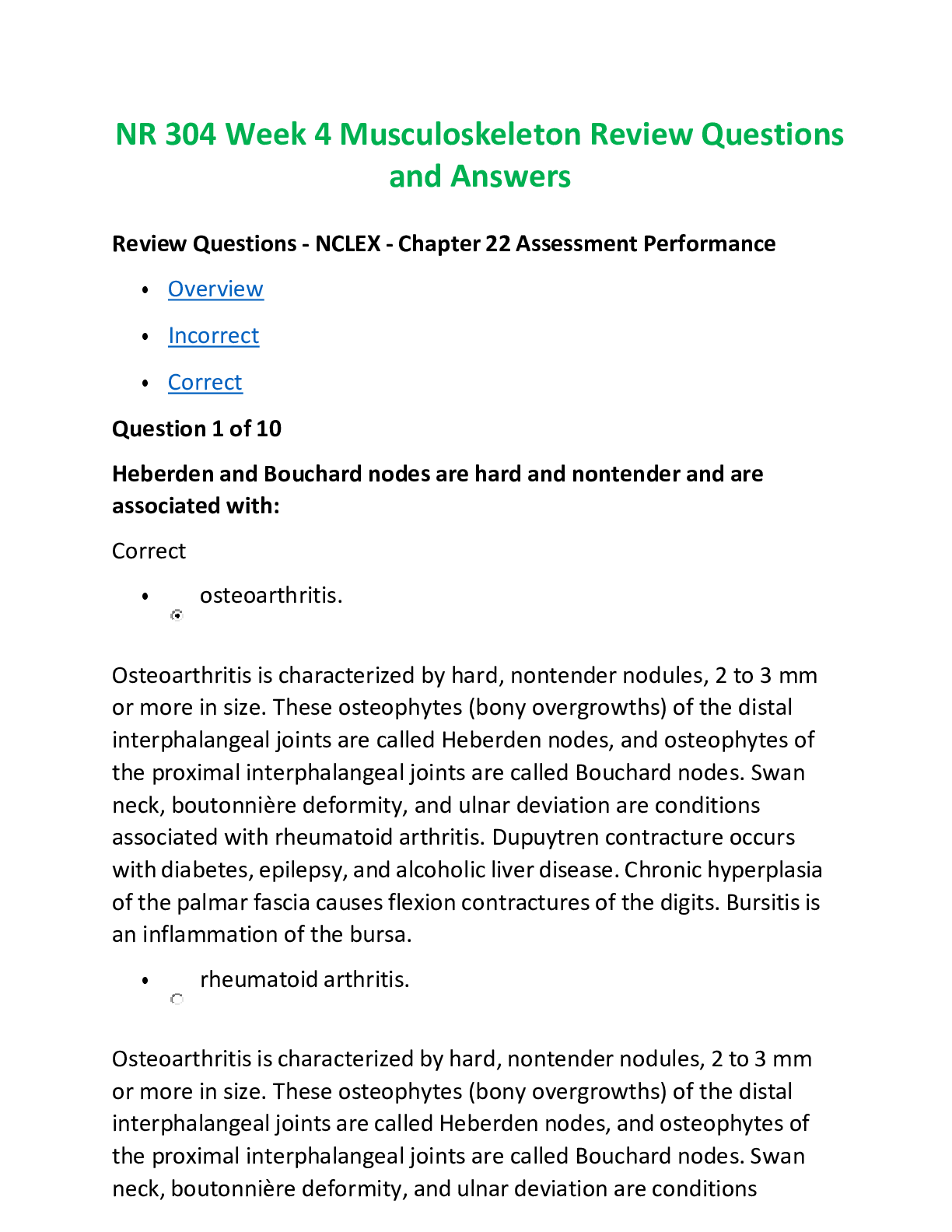
Reviews( 0 )
Document information
Connected school, study & course
About the document
Uploaded On
Aug 04, 2022
Number of pages
47
Written in
Additional information
This document has been written for:
Uploaded
Aug 04, 2022
Downloads
0
Views
40




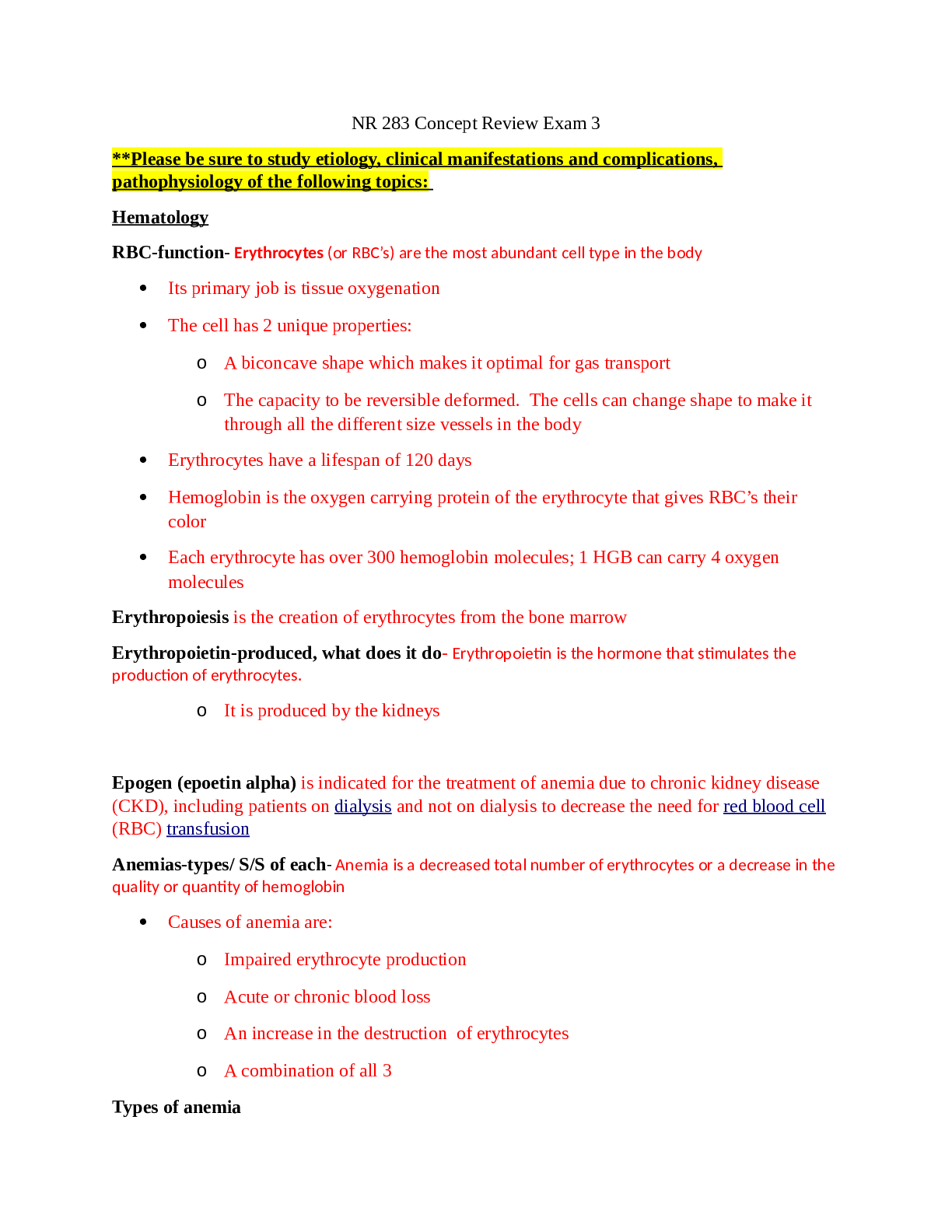

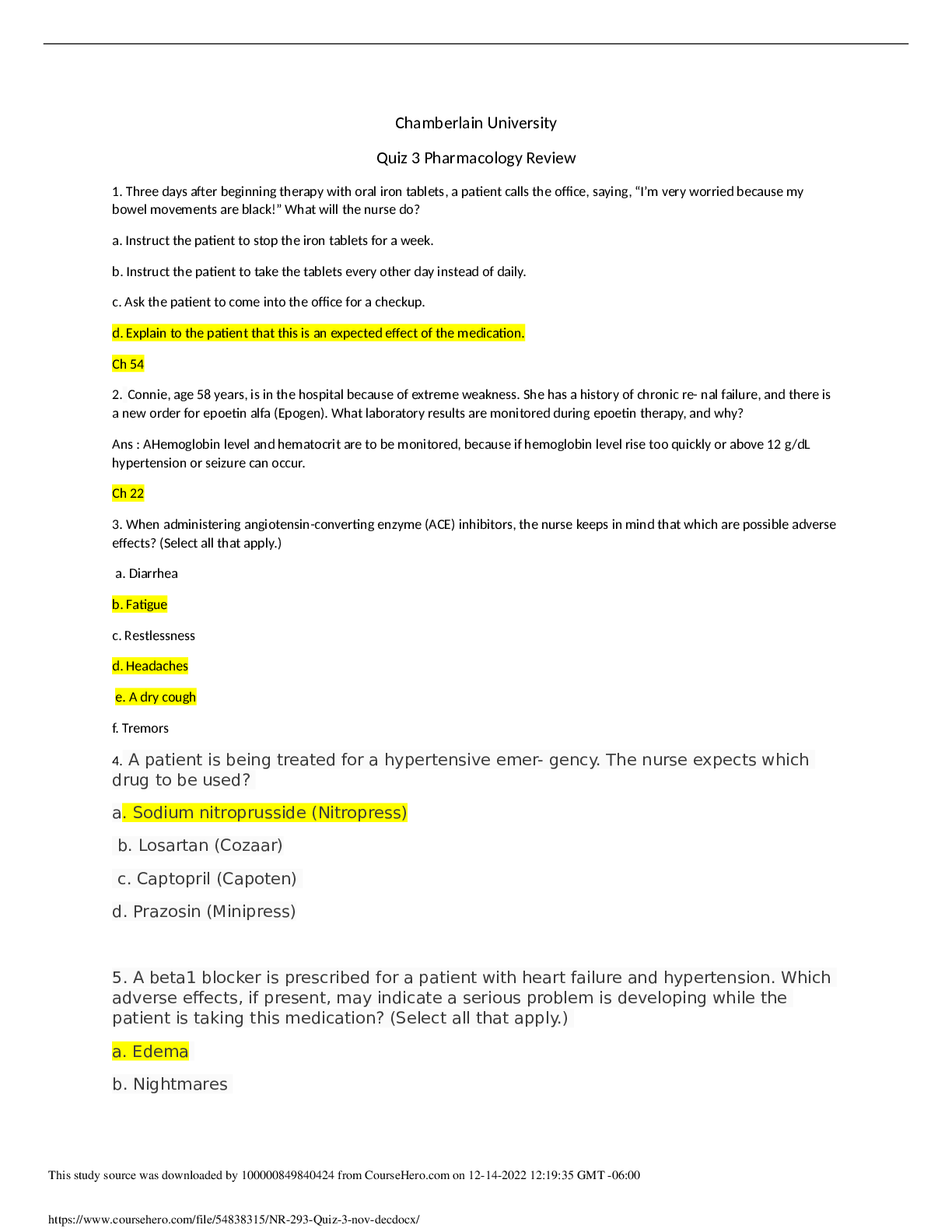

.png)
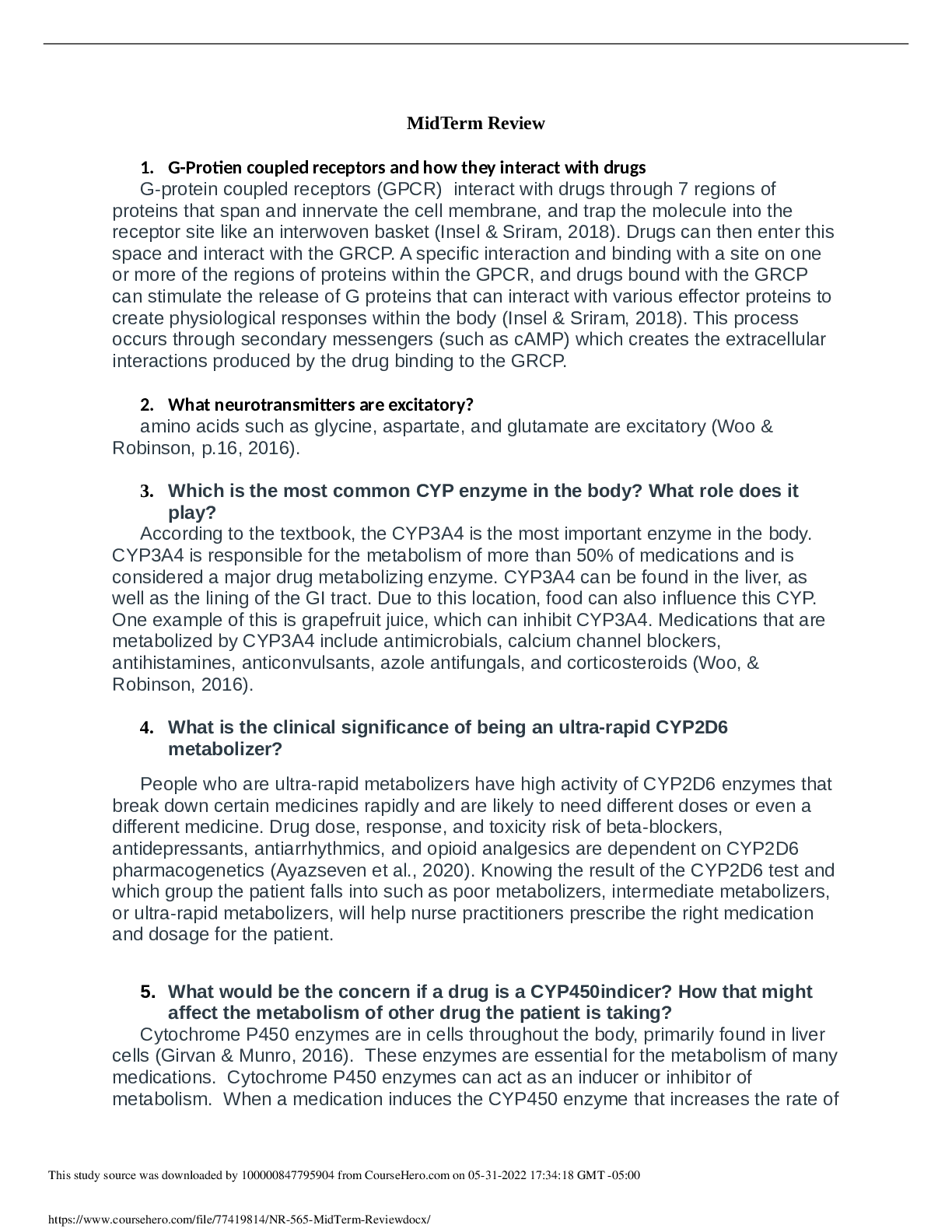
.png)

